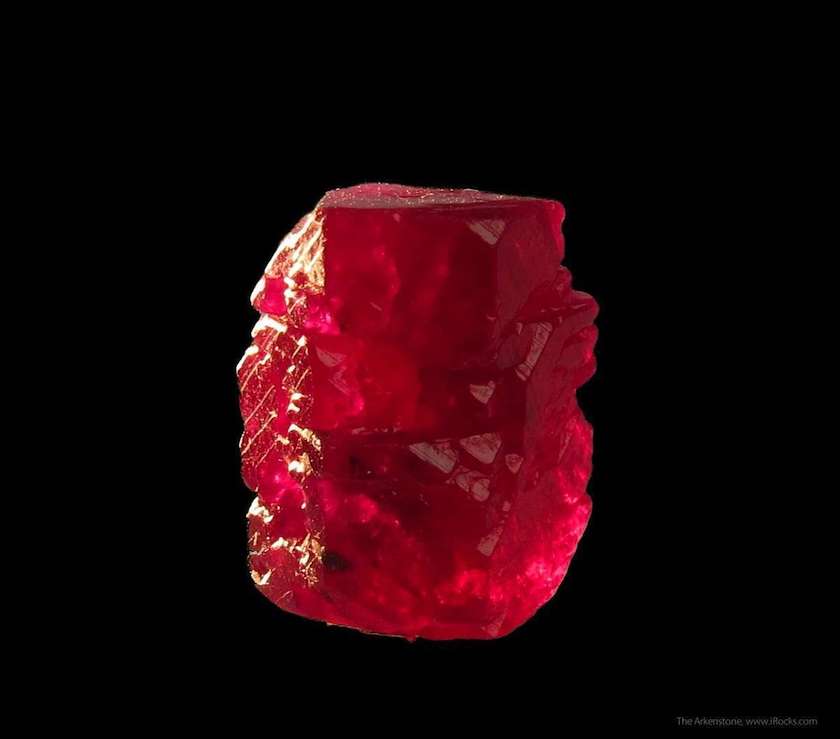Do Natural Rubies Fluoresce?
Both natural and synthetic rubies fluoresce under UV light. Learn how slight differences in fluorescence patterns can help gemologists distinguish them.
1 Minute Read
This ruby crystal on a zoisite matrix has a cherry-red fluorescence under ultraviolet (UV) light. Mundarara Mine, Arusha Region, Tanzania. Photos © Rob Lavinsky, www.iRocks.com. Used with permission.
Answer: All rubies fluoresce, whether they're mined or created in a lab, since natural and synthetic ruby gemstones have the same chemical composition and physical properties. However, there are slight differences in fluorescence patterns between natural and synthetic stones and even between natural rubies from different sources.
Interested in this topic?
This article is also a part of our Ruby Specialist Mini Course, in the unit Distinguishing Synthetic and Simulant Ruby.
Fluorescence of Rubies from Various Sources
For example, flame fusion is the most common way to synthesize corundum gems, which includes rubies and sapphires. Flame fusion rubies fluoresce stronger than natural gems. This can be used as a clue during identification.
In practice, it's sometimes a very difficult determination to make. However, when you have a tiny stone that doesn't yield much information, every little bit helps.
The following is an overview of how some rubies fluoresce under longwave (LW) and shortwave (SW) UV light.
- Myanmar (Burma) Rubies: LW strong red. SW moderate red.
- Sri Lanka (Ceylon) rubies: LW strong orange/red. SW moderate orange/red.
- Thai rubies: LW weak red. SW inert.
- Flame fusion rubies (synthetic): LW very strong orange/red. SW moderate to strong orange/red.
- Flux-grown rubies (synthetic): LW Strong orange/red. SW orangey red and may have a blue tint or areas of blue.
I hope this helps to clarify things for you,
Don Clark, CSM IMG
Additional Comments on "Do Natural Rubies Fluoresce?" from the IGS on Facebook
Natural rubies fluoresce a bit. Natural Burma rubies GLOW!
Elaine Hochberg
The fact that raw hexagonal ruby crystals can fluoresce, and crystal cross-sections in matrix can also fluoresce, is a definitive answer.
Angel Brick
I have a number of rubies from Burma that are natural and light up like a Christmas tree under UV light, like the rubies that Jeffery shared on this post. I can't speak about synthetics since I've not tested one under UV light.
Jerry Anderson Jr.
Don't forget that synthetic rubies have the same physical, chemical, and optical properties of a natural ruby so both fluoresce, but Burmese rubies more so, definitely.
Jennifer Simonds
This ruby crystal on white marble matrix displays outstanding fluorescence. 2.9 x 2.6 x 1.1 cm, Nangimali, Neelum Valley, Azad Kashmir, Pakistan. © Rob Lavinsky, www.iRocks.com. Used with permission.
International Gem Society
Related Articles
Ruby Gemstone Value, Price & Jewelry Insights
Advice For Grading Dark Colored Gemstones
10 Gemstones Rarer than Diamond: The Earth’s Scarcest Treasures
Are Serengeti Rubies Real Rubies?
Latest Articles
800 Years of Mogok: A Celebration in Tenuous Times
What is the Average Gemstone Faceting Yield?
Pyroxmangite Value, Price, and Jewelry Information
How to Identify Emerald Simulants and Synthetics
Never Stop Learning
When you join the IGS community, you get trusted diamond & gemstone information when you need it.
Get Gemology Insights
Get started with the International Gem Society’s free guide to gemstone identification. Join our weekly newsletter & get a free copy of the Gem ID Checklist!
